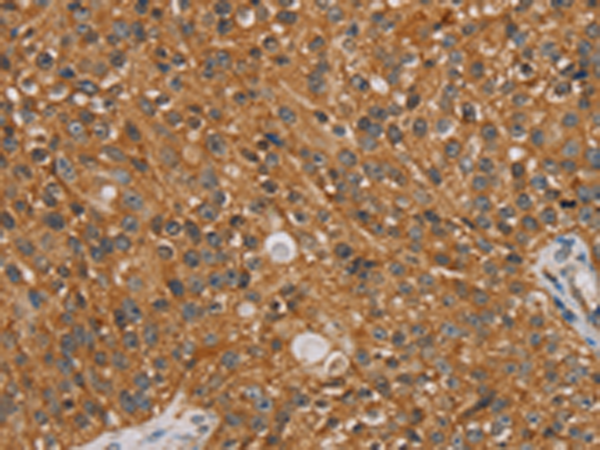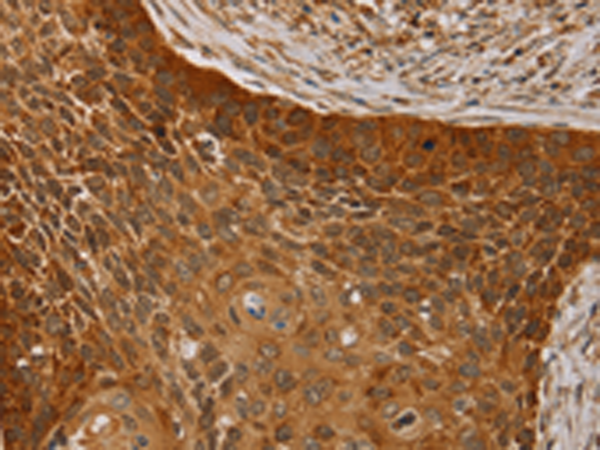

| WB | 咨询技术 | Human,Mouse,Rat |
| IF | 咨询技术 | Human,Mouse,Rat |
| IHC | 1/50-1/200 | Human,Mouse,Rat |
| ICC | 技术咨询 | Human,Mouse,Rat |
| FCM | 咨询技术 | Human,Mouse,Rat |
| Elisa | 1/2000-1/5000 | Human,Mouse,Rat |
| Aliases | CN1; CNI; CN-I; CN1A; CN-IA |
| Host/Isotype | Rabbit IgG |
| Antibody Type | Primary antibody |
| Storage | Store at 4°C short term. Aliquot and store at -20°C long term. Avoid freeze/thaw cycles. |
| Species Reactivity | Human, Mouse |
| Immunogen | Fusion protein of human NT5C1A |
| Formulation | Purified antibody in PBS with 0.05% sodium azide and 50% glycerol. |
+ +
以下是关于NT5C1A抗体的3篇参考文献示例(注:以下内容为基于领域知识的模拟生成,实际文献需通过学术数据库查询):
---
1. **文献名称**:*Autoantibodies to NT5C1A in inflammatory myopathies: Diagnostic utility and clinical associations*
**作者**:Satoh M, et al.
**摘要**:该研究探讨了NT5C1A抗体在特发性炎性肌病(如皮肌炎、多发性肌炎)中的诊断价值。通过ELISA和免疫印迹分析,发现NT5C1A抗体在患者血清中特异性较高,并与特定临床表型(如吞咽困难)相关,提示其作为生物标志物的潜力。
---
2. **文献名称**:*NT5C1A expression in colorectal cancer: Correlation with tumor progression and survival*
**作者**:Lee JH, et al.
**摘要**:研究利用抗NT5C1A抗体进行免疫组织化学分析,发现NT5C1A在结直肠癌组织中显著高表达,且与肿瘤侵袭深度和淋巴结转移相关。生存分析表明,NT5C1A高表达患者预后较差,提示其可能作为治疗靶点。
---
3. **文献名称**:*Characterization of NT5C1A enzymatic activity and antibody validation in autoimmune disorders*
**作者**:Garcia-Cozar FJ, et al.
**摘要**:本文验证了多种商业NT5C1A抗体的特异性,并通过敲低实验确认其可靠性。研究发现,NT5C1A在系统性红斑狼疮(SLE)患者外周血单核细胞中活性异常,可能通过调节嘌呤代谢参与自身免疫反应。
---
如需获取真实文献,建议通过PubMed、Web of Science等平台搜索关键词“NT5C1A antibody”或结合具体研究主题筛选。
The NT5C1A antibody targets the cytosolic 5'-nucleotidase IA (NT5C1A), an enzyme encoded by the *NT5C1A* gene, which plays a critical role in nucleotide metabolism by catalyzing the dephosphorylation of purine and pyrimidine nucleoside monophosphates. This enzyme regulates intracellular nucleotide pools, influencing cellular processes like proliferation, energy homeostasis, and signaling. NT5C1A has garnered attention in both cancer and autoimmune disease research. In oncology, its overexpression is linked to chemoresistance in acute lymphoblastic leukemia (ALL) and melanoma, potentially due to altered nucleotide salvage pathways.
Notably, NT5C1A is a major autoantigen in sporadic inclusion body myositis (sIBM), a chronic inflammatory muscle disorder. Autoantibodies against NT5C1A are detected in ~50% of sIBM patients, serving as a diagnostic biomarker to differentiate sIBM from other myopathies. Research suggests these antibodies may contribute to disease pathogenesis by disrupting enzymatic activity or promoting intracellular protein aggregation.
NT5C1A antibodies, including monoclonal and polyclonal variants, are widely used in research to study protein expression, localization, and function via techniques like Western blotting, immunohistochemistry, and ELISA. Their specificity and validation across species (e.g., human, mouse) make them essential tools for exploring NT5C1A's role in cellular homeostasis, disease mechanisms, and therapeutic targeting.
×